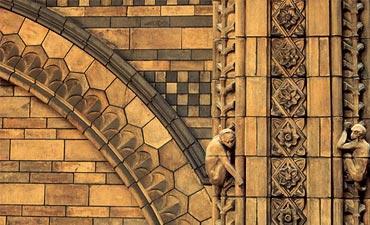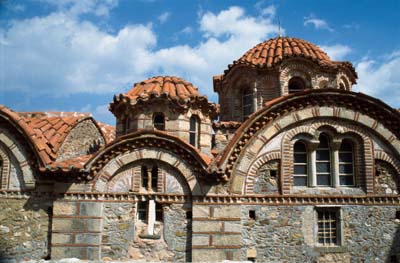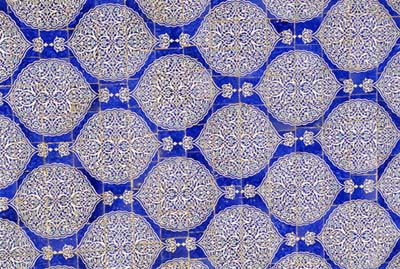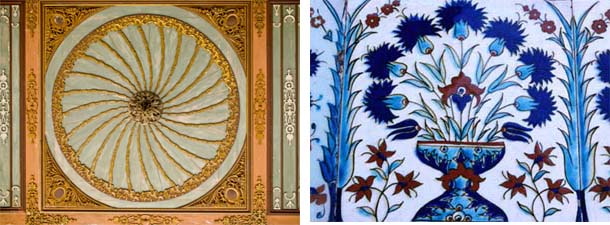Apr 21, 2025
Apr 21, 2025
by Rachna
 Architectural development cannot be talked about without the mention of building materials. Discovery of each new building material shows the advent of new technology and thus, marks the beginning of a new era, a new style, a trend in the architectural construction and its techniques.
Architectural development cannot be talked about without the mention of building materials. Discovery of each new building material shows the advent of new technology and thus, marks the beginning of a new era, a new style, a trend in the architectural construction and its techniques.
When early man left caves and graduated to hutments, Mud became the main building material. The accidental discovery of fire not only changed the way of living but also the place of living, transforming the sun-dried mud bricks to baked mud bricks. Terracotta (baked earth), the evergreen building material, paved the path for Ceramics and its vitality & indispensability till date to the field of Architecture.
The most of the usage of ceramics in architectural construction and details can be seen in terms of tiles.
Roof & Floor Tiles
 These were designed formerly for the sole function of keeping out rainwater and were traditionally made from locally available clay: Terracotta Tiles. These terracotta tiles offered a wide range of patterns and design both in terms of function (primarily) and aesthetics. Some of the types include Flat tiles, imbrex or tegula (Ancient Roman curved and flat tiles), Pan tiles (S-shaped tiles for interlocking; mainly prevalent in the late 19th century in England and USA), Mission or barrel tiles (semi-cylindrical tiles) and the famous Mangalore roofing Tiles back home. The roof tiles are usually hung in parallel rows, with each row overlapping the row below it in order to exclude rainwater and also to cover the nails that are used to fix and hold the row below. Some of the roof tiles are specially designed and hence have the name defining the purpose they serve. These include ridge, hip and valley tiles.
These were designed formerly for the sole function of keeping out rainwater and were traditionally made from locally available clay: Terracotta Tiles. These terracotta tiles offered a wide range of patterns and design both in terms of function (primarily) and aesthetics. Some of the types include Flat tiles, imbrex or tegula (Ancient Roman curved and flat tiles), Pan tiles (S-shaped tiles for interlocking; mainly prevalent in the late 19th century in England and USA), Mission or barrel tiles (semi-cylindrical tiles) and the famous Mangalore roofing Tiles back home. The roof tiles are usually hung in parallel rows, with each row overlapping the row below it in order to exclude rainwater and also to cover the nails that are used to fix and hold the row below. Some of the roof tiles are specially designed and hence have the name defining the purpose they serve. These include ridge, hip and valley tiles.
Influence in History
Almost all of the early civilizations boost of the usage of fired roof tiles. Through archaeological excavations, evidence of terracotta tiles are found in Indus Valley Civilization, the Early Helladic House (4th millennium BC), Mycenaean period, Archaic Greece: the city of Corinth, the temple of the Apollo and Poseidon (between 700-650 BC), Eastern Mediterranean, Western Asia Minor, Southern & Central Italy, to name a few.
Apart from the waterproofing another quality that lead to the widespread of terracotta tiles, especially in Temple and Monumental Architecture was fire-resistance.
 Most commonly used material for flooring, till date is Ceramic tiles. Its painting and glazing properties which added the color and numerous patterns therefore, made it the favorite. The tiles were earlier made slip-resistant for use in wet areas either by using small sized tiles so that the grout lines acted as grooves or contoured and patterned, textured tiles were used (& still used) for the anti-skid action. Its scratch resistance and light weight are added benefits.
Most commonly used material for flooring, till date is Ceramic tiles. Its painting and glazing properties which added the color and numerous patterns therefore, made it the favorite. The tiles were earlier made slip-resistant for use in wet areas either by using small sized tiles so that the grout lines acted as grooves or contoured and patterned, textured tiles were used (& still used) for the anti-skid action. Its scratch resistance and light weight are added benefits.
Tiles for Decoration and Color
History is full of excellent and extensive examples of decorative tile work and mosaic work courtesy ceramics. The earliest evidence of glazed brick is the discovery of glazed bricks in the Elamite Temple at Chogha Zanbil, dated to the 13th century BCE. Glazed and colored bricks were used to make low reliefs in Ancient Mesopotamia, most famously the Ishtar Gate of Babylon (ca. 575 BCE), now partly reconstructed in Berlin, with sections elsewhere. Mesopotamian craftsmen were imported for the palaces of the Persian Empire such as Persepolis.
Islamic Tile
After the Islamic conquest of Persia, colored and often painted glazed bricks or tiles became an important element in Persian architecture, and from there spread to much of the Islamic world, notably the Iznik pottery of Turkey under the Ottoman Empire (16th and 17th centuries).

Palaces, public buildings, churches, bazaars and mosques were heavily decorated with dense, often massive patterns and friezes of astonishing complexity, including floral motifs and calligraphy as well as geometric patterns.
Western Tile Work
 Transmitted via Islamic Spain, a new tradition of Azulejos developed in Spain and especially Portugal, which by the Baroque period produced extremely large painted scenes on tiles, usually in blue and white. Delftware tiles, typically with a painted design covering only one (rather small) tile, were ubiquitous in Holland and widely exported over Northern Europe from the 16th onwards. Several 18th century royal palaces had porcelain rooms with the walls entirely covered in porcelain in tiles or panels e.g. Capodimonte, Naples, the Royal Palace of Madrid and the nearby Royal Palace of Aranjuez. There are several other types of traditional tiles that are still manufactured, for example the Moroccan Tiles: small, almost mosaic, brightly colored tiles of Morocco. Portugal and São Luís continue their tradition of azulejo tile work today. In the United States and other Western countries, decorative tiles were in vogue in the 1920s and 1930s.
Transmitted via Islamic Spain, a new tradition of Azulejos developed in Spain and especially Portugal, which by the Baroque period produced extremely large painted scenes on tiles, usually in blue and white. Delftware tiles, typically with a painted design covering only one (rather small) tile, were ubiquitous in Holland and widely exported over Northern Europe from the 16th onwards. Several 18th century royal palaces had porcelain rooms with the walls entirely covered in porcelain in tiles or panels e.g. Capodimonte, Naples, the Royal Palace of Madrid and the nearby Royal Palace of Aranjuez. There are several other types of traditional tiles that are still manufactured, for example the Moroccan Tiles: small, almost mosaic, brightly colored tiles of Morocco. Portugal and São Luís continue their tradition of azulejo tile work today. In the United States and other Western countries, decorative tiles were in vogue in the 1920s and 1930s.
 Mughal Tiles
Mughal Tiles
In the Mughal era, the use of tiles was very extensive right from domes, the chhatris, jharokhas, chajjas, jails, the furniture, the fountains, pools, pillars and columns to floors. Almost all the buildings of the Mughal Empire had explicitly involved tiles. Almost all the patterns, colors, textures, designs perceived by a human mind can be seen in the buildings of this era, but the most lavishly used were the cobalt blue ceramic glazed tiles.
The Firoz shah tomb, the Humayun’s tomb, the red fort, Agra fort and palace, the wonder Taj Mahal the list examples are never ending.
Present day Architecture
In today’s times, the use of ceramics can be seen everywhere in architecture, be it the daily kitchen wares, the sanitary fixtures, garden accessories and planters, or the most noted and obvious tiles.
 Talking about ceramic tiles they are the undisputable kings when it comes to furnishing bathrooms, toilets, and kitchens. The Mangalore tiles are still a common and preferred roofing material. Ceramic floor and wall tiles still offer a wide range of colors, textures and patterns to lure architects and designers. Tiles in the exterior are still preferred for the water-resistant, fire resistant, anti corrosive, easy maintenance, wide color range.
Talking about ceramic tiles they are the undisputable kings when it comes to furnishing bathrooms, toilets, and kitchens. The Mangalore tiles are still a common and preferred roofing material. Ceramic floor and wall tiles still offer a wide range of colors, textures and patterns to lure architects and designers. Tiles in the exterior are still preferred for the water-resistant, fire resistant, anti corrosive, easy maintenance, wide color range.
Conclusion
Modern technology and advancement has given us innumerable building and construction materials, but no one can deny the beauty, aura and magnanimity of this magnificent building material: the ceramic tile. Over a time a large number of shapes (or "profiles"), textures, glazes of tiles have evolved and research and advancements are still happening, the Ceramic tile is bound to stay no matter what and its significant rendering to architecture and history over the civilizations is undeniable.
11-Oct-2009
More by : Rachna

|
Very informative. |

|
written very nice about mughal and others, those used ceramic tile in their architectre,, good information for the student of ceramics,,,,, |